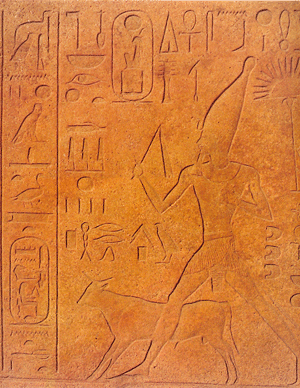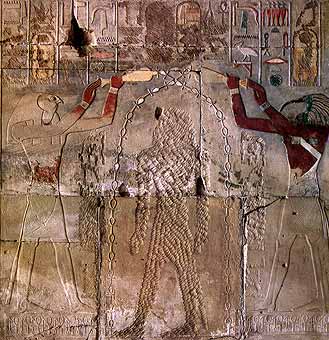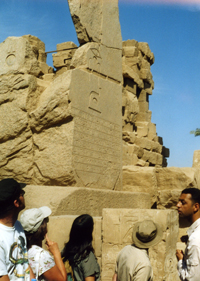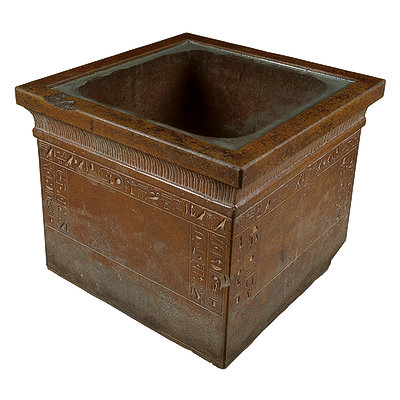Hatshepsut
The female pharaoh Hatshepsut is the King Herself. So who was she?
|
Statue of Hatshepsut in the Metropolitan Museum in New York. Isn't she lovely? |
How did Hatshepsut become pharaoh?
Hatshepsut lived around 3,500 years ago. In ancient times women very rarely ruled countries - it was considered a man's job. So how did she become the most powerful person on the planet?
Hatshepsut was the daughter of the pharaoh Thutmose I (also known as Tuthmosis I, although his name in Egyptian is more like Djehutymes). Thutmose I was a strong king who conquered large parts of the Middle East, such as Palestine. After he died his son Thutmose II took over. Hatshepsut was married to Thutmose II, her half brother (royal marriages were often kept within the family to make sure outsiders could not take power.) With one of his other queens Thutmose II had a son, also known as Thutmose.
After Thutmose II died (after only 3 years as king), this younger Thutmose became king - Thutmose III. However, he was a young child, or even a baby, so Hatshepsut became what we call the regent. This means she ran things for him. She was still young herself - probably between 15 and 20. In these early years Thutmose III alone was described in hieroglyphic inscriptions as the 'King of Upper and Lower Egypt and Lord of the Two Lands'. But five years later - Year 7 of Thutmose's reign - things changed.
Click here to see a family tree (the same as the one in the book).
The King Herself
In her early 20s Hatshepsut decided to take over. In year 7 of Thutmose III's reign, we start to see her new throne name, Maatkare - meaning 'Right is the soul of the sun god Re', or perhaps 'the soul of Re is righteous'. (pronounce it 'Maat-kah-ray'). She was now the Female Horus of Fine Gold, King of Upper and Lower Egypt, Maatkare, the One who is joined with Amun, Hatshepsut.
 This
was not a revolution, but a gradual change. Sneaky. But Hatshepsut had a
problem - she was a woman, and she had taken over from the 'true' king. How
could she convince the Egyptians to accept her as their sovereign?
This
was not a revolution, but a gradual change. Sneaky. But Hatshepsut had a
problem - she was a woman, and she had taken over from the 'true' king. How
could she convince the Egyptians to accept her as their sovereign?
She did a couple of clever things. First, she had herself always depicted in carvings and statues as a man. We can see this in the picture left from her Red Chapel at Karnak temple. You can also see her name written in cartouches - Maatkare at the top and Hatshepsut at the bottom. Most Egyptians would never see her in person, but mainly in these pictures. They would know she was really a woman, but they would accept her more if she was shown as a man.
Second, she spread the idea that in fact the king of the gods, Amun, had always wanted her to be the king, and she had in fact been king right from the start (after Thutmose II died). She was rewriting history. Even sneakier, she had a series of pictures painted in her temple which showed that her true father was Amun! So if she was the daughter of Amun, and had always been king anyway, who was going to argue?
No one, probably. At least until she was dead.
More about Hatshepsut's divine birth
Hatshepsut's Reign
Hatshepsut had a fairly successful reign - Egypt was prosperous and peaceful. The art of this time is exquisite - beautifully shaped and cut hieroglyphs. In fact my favourite hieroglyphs from the whole of Egyptian history - truly elegant. Hatshepsut ruled for about 22 years (my story takes place in year 18 of her reign, so about 4 years before she died at the age of roughly 40.)
She built various things such as her obelisks in Karnak temple (two pairs), the Red chapel and a pylon at Karnak, several tombs including her extension of KV20, and of course her temple Djeser Djeseru.
After Hatshepsut's Death
After Hatshepsut died, Thutmose III took over properly as king. He was a vigorous young man who conquered even more of Asia than his grandfather. He went on 17 separate campaigns, almost every year. He built many temples and other constructions. He even built a temple right next to Hatshepsut's which is now in ruins.
About 20 years after Hatshepsut died, he decided that the Egyptians should forget his stepmother had ever ruled. We aren't certain why - some have argued that he hated her for taking over the throne from him when he was young. But this is unlikely. All the signs are that they got along well. Plus he waited a very long time to start his campaign of obliterating her from history, so it's unlikely he was that angry about it. Perhaps his ego had grown so much because of his great success as a king and general that he didn't want people to remember he had stood in the shade of a woman during his younger years. So what did he do?
Campaign of Destruction
Thutmose ordered almost every image of Hatshepsut, and her cartouches (her name), to be destroyed. Scribes carefully chiselled out her name and image from temples like Karnak and Djeser Djeseru. If you visit Egypt you will see this everywhere. The picture right is from Karnak temple. Horus and Thoth are pouring holy water over her in the forms of ankh signs. Both her image and her name have been carved out.
 As
I mention in the book, both of her obelisks had walls built round them, and
one was also knocked down. The wall, however, protected the remaining
obelisk very nicely and it is now in beautiful condition. The picture left
was taken by me in 2001 and shows the fragments of one obelisk with the
remains of the wall, and also my tour guide
As
I mention in the book, both of her obelisks had walls built round them, and
one was also knocked down. The wall, however, protected the remaining
obelisk very nicely and it is now in beautiful condition. The picture left
was taken by me in 2001 and shows the fragments of one obelisk with the
remains of the wall, and also my tour guide
Ahmed to the right!

Where is she now?
For a long time nobody knew what had happened to Hatshepsut's mummy. A few candidates were proposed - various female mummies, one of which is probably Hatshepsut's wet nurse, Sit-re.
Very little was left in her tomb, but there was one Canopic jar containing her liver, as well as her sarcophagus and the case for the Canopic jars (see right).
And then in June this year, the Egyptians announced that they had found her mummy!
Click here for an article about finding Hatshepsut's mummy by Zahi Hawass, the head of the Supreme Council of Antiquities in Egypt
Hatshepsut's mummy
Looks like this:

Yuk! Not so lovely any more. But not bad for a 3,500 year-old.
The Papyrus Message
The message Danny translates is what is on your bookmark if you bought the book. To translate it go here.

If any experts out there think I've made a mistake, please let me know!
By the way, the trick with the conker actually works! Try it.
